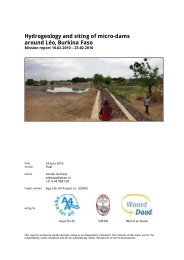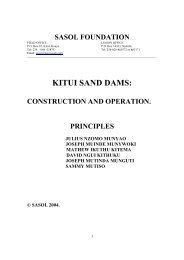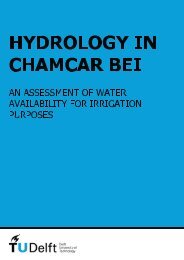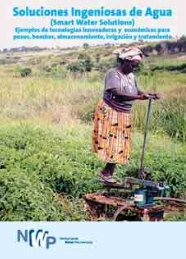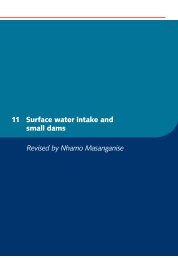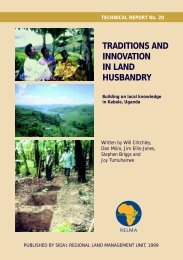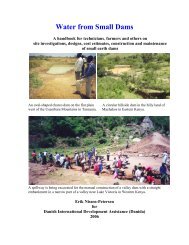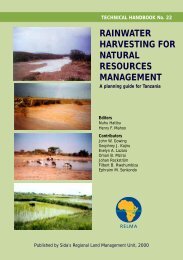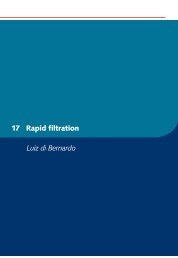l/dAverage monthly <strong>solar</strong> <strong>still</strong> output and rainwater harvesting (l/d)700Rainwater harvesting600Solar <strong>still</strong>5004003002001000Jan Feb Mar Apr May June July Aug Sep Oct Nov DecMonthFigure 5: Average rainwater harvesting (l/d) added to <strong>the</strong> daily output <strong>of</strong> a <strong>solar</strong> <strong>still</strong> with an efficiency <strong>of</strong> 15%Water qualityLittle research has been done regarding <strong>the</strong> water quality <strong>of</strong> <strong>the</strong> water produced by <strong>solar</strong>-<strong>still</strong>s based on pollutedor muddy water. However it is proven that nitrates, chlorides, iron, heavy metals and dissolved solids arecompletely removed by <strong>the</strong> <strong>solar</strong> <strong>still</strong> (Al-Hayek and Badran, 2004 and Zein and Al-Dallal, 1984). The processalso proved to be effective in <strong>the</strong> destruction <strong>of</strong> microbiological organisms present in <strong>the</strong> feed water (Al-Hayekand Badran, 2004). The di<strong>still</strong>ate is thus high purity water, which also lacks essential dissolved minerals.Drinking demineralised water can have serious health consequences, and it is thus <strong>of</strong> crucial importance that <strong>the</strong>essential minerals are added to <strong>the</strong> water before consumption (WHO, 2004b). The advised quantities <strong>of</strong> mineralswhere minimum or no adverse health effects are observed are shown are shown in Table 4.Table 4: Advised mineralogical quantities (from WHO, 2004b)Total DissolvedSolids (mg/l)Bicarbonateion (mg/l)Calcium(mg//l)Magnesium(mg/l)Hardness(mmol/l)Alkalinity(meq/l)Minimum 100 30 20 10Optimum 250-500 40-80 20-30 2-4Maximum 6.5It is however believed that no addition <strong>of</strong> minerals will be required in this case as <strong>the</strong> <strong>still</strong> di<strong>still</strong>ate will be storedin <strong>the</strong> same tank as <strong>the</strong> rain water will be, and also because <strong>the</strong> process will not be 100% clean. This will sufficeas a natural re-mineralization <strong>of</strong> <strong>the</strong> water. If <strong>the</strong> water seems to be too low on certain minerals, it is possible tore-mineralise it in an affordable and simple way by dissolution <strong>of</strong> natural occurring minerals (Hasson andBendrihem, 2006 and Ruggieri et al., 2008). Budunbuto is located in a limestone rich area. Running <strong>the</strong> di<strong>still</strong>atethrough a limestone bed can provide essential elements to <strong>the</strong> water (Hasson and Bendrihem, 2006 and Ruggieriet al., 2008). The process is as follows:CaCO3+ CO2+ H2O = Ca 2+ + 2HCO 3- (10)As a result <strong>the</strong> calcium, hardness and alkalinity concentrations are increased (Hasson and Bendrihem, 2006 andRuggieri et al., 2008). Remineralisation rates can differ significantly based on <strong>the</strong> chemical and mineralogicalcomposition and texture <strong>of</strong> <strong>the</strong> limestone used (Ruggieri et al., 2008). According to <strong>the</strong> European Norm EN1018:1998, which assess <strong>the</strong> composition <strong>of</strong> limestone used for water treatment, <strong>the</strong> limestone should contain>85% <strong>of</strong> calcite.10
Practical applicationWhen implementing a <strong>solar</strong> <strong>still</strong> system on <strong>the</strong> berkads it is essential that <strong>the</strong> design is as simple as possible but<strong>still</strong> effective. Keeping in mind <strong>the</strong> economic and logistic aspects, affordable and local materials should be usedwhenever possible. Never<strong>the</strong>less, to guarantee a good functioning <strong>of</strong> <strong>the</strong> system, some parts need to beimported.For Budunbuto, a single slope <strong>solar</strong> <strong>still</strong> is preferred above a double slope <strong>solar</strong> <strong>still</strong>, as having only one slopeequals to having only one internal gutter which can be easily connected to <strong>the</strong> drink water storage tank. Toincrease <strong>the</strong> <strong>solar</strong> interception, <strong>the</strong> <strong>solar</strong> <strong>still</strong> needs an equator facing top cover, with <strong>the</strong> length <strong>the</strong>refore linedon an east-west axis (this might be problematic for already existing berkads, which might not be orientatedproperly). The top cover should be set at an angle <strong>of</strong> 10º, which is considered to be <strong>the</strong> most accepted angle for asingle slope <strong>solar</strong> <strong>still</strong> at this latitude (Khalifa, 2010). It should be made ei<strong>the</strong>r out <strong>of</strong> a 3-4 mm thick glass or aultra-violet resistant polyvinyl chloride (PVC) sheet. As mentioned above, glass is <strong>the</strong> preferred material as itincreases <strong>the</strong> efficiency <strong>of</strong> <strong>the</strong> <strong>solar</strong> <strong>still</strong>. When choosing for a glass cover, it is important that <strong>the</strong> structure <strong>of</strong> <strong>the</strong><strong>still</strong> is build to carry <strong>the</strong> weight <strong>of</strong> <strong>the</strong> relatively heavy glass. The sides <strong>of</strong> <strong>the</strong> <strong>still</strong> should be closed in order tomake <strong>the</strong> <strong>still</strong> airtight. This could be done by using <strong>the</strong> same material chosen for <strong>the</strong> top cover. At <strong>the</strong> inlet <strong>of</strong> <strong>the</strong>surface run<strong>of</strong>f water, a one way door should be placed (Figure 6). This would allow <strong>the</strong> surface run<strong>of</strong>f water t<strong>of</strong>low into <strong>the</strong> berkad during periods <strong>of</strong> rainfall, as <strong>the</strong> door would <strong>the</strong>n open under <strong>the</strong> weight <strong>of</strong> <strong>the</strong> water, but itwould remain shut during dry periods.The condensed water should be collected in a gutter fixed along <strong>the</strong> lower edge <strong>of</strong> <strong>the</strong> cover. On <strong>the</strong> outerside <strong>of</strong> <strong>the</strong> cover a similar gutter should be placed for <strong>the</strong> collection <strong>of</strong> <strong>the</strong> rainwater. Both gutters should beplaced on a small angle to let <strong>the</strong> water run towards <strong>the</strong> airtight pipes that connect it to <strong>the</strong> drinking water tank.Both gutters should also be made <strong>of</strong> a material that is not affecting <strong>the</strong> properties <strong>of</strong> <strong>the</strong> water and so should <strong>the</strong>airtight pipes be. Particular attention needs to be used when installing <strong>the</strong> rain water collection gutter, as factorsas <strong>the</strong> weight <strong>of</strong> <strong>the</strong> water in <strong>the</strong> gutter and <strong>the</strong> wind effects should be considered. It is also advised to add agutter screen (e.g. a simple mesh with a fine pattern), as debris from <strong>the</strong> ro<strong>of</strong> may collect in <strong>the</strong> gutter,obstructing it.The clean water storage tank should be placed in <strong>the</strong> immediate vicinity <strong>of</strong> <strong>the</strong> berkad and should be properlyclosed, preventing any light from entering. It is advised to place <strong>the</strong> drinking water tank in <strong>the</strong> ground (lowerthan <strong>the</strong> gutters), as in this way <strong>the</strong> water would flow under gravity towards <strong>the</strong> tank.A hand pump should be used for <strong>the</strong> extraction <strong>of</strong> <strong>the</strong> drinking water from <strong>the</strong> tank, which should solely be usedfor human consumption. Ano<strong>the</strong>r hand pump should be used for <strong>the</strong> extraction <strong>of</strong> <strong>the</strong> water from <strong>the</strong> berkad,which should be used for animal watering and o<strong>the</strong>r domestic use (washing, cooking, etc.).Very important in <strong>the</strong> design <strong>of</strong> <strong>the</strong> system is that all <strong>the</strong> joints and fittings are accurately isolated to preven<strong>the</strong>at loss. For this reason, a one way valve could be placed at connection point <strong>of</strong> <strong>the</strong> internal gutter and <strong>the</strong> pipethat goes to <strong>the</strong> drinking water tank.This type <strong>of</strong> <strong>solar</strong> <strong>still</strong> systems requires little maintenance; however <strong>the</strong> following aspects should regularly bechecked:- The fittings and joints, in order to prevent colder air flow from outside into <strong>the</strong> <strong>solar</strong> <strong>still</strong>.- The top cover, which should be checked for cracks and scratches which may reduce <strong>the</strong> <strong>solar</strong>transmittance. When using a PVC cover, it should be replaced after about 2 to 4 years.- The waste product that is left over in <strong>the</strong> berkad at <strong>the</strong> end <strong>of</strong> <strong>the</strong> dry season should periodically beremoved. It should be disposed outside <strong>of</strong> <strong>the</strong> catchment area <strong>of</strong> <strong>the</strong> berkads, to prevent it from reentering<strong>the</strong> system.The above described advisable design for <strong>the</strong> <strong>solar</strong> <strong>still</strong>s in Budunbuto is very simple and (thus) not optimallyefficient. It has been chosen to keep <strong>the</strong> design simple because an increase in <strong>the</strong> efficiency and productivity <strong>of</strong><strong>the</strong> <strong>still</strong> is usually coupled to an increase in cost, which is an undesirable result. With this design, <strong>the</strong> <strong>solar</strong> <strong>still</strong>srepresent a low cost technology with low cost maintenance, which can be carried out by unskilled manpower(Tiwari et al., 2003).11



